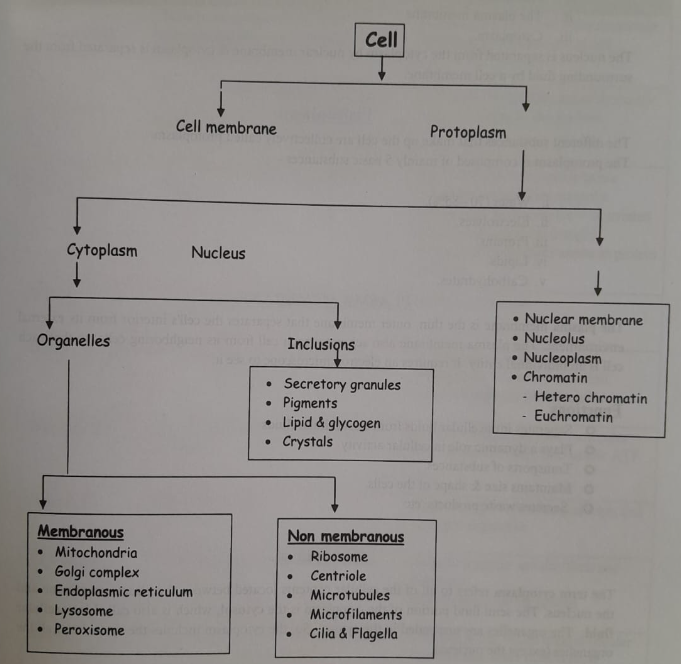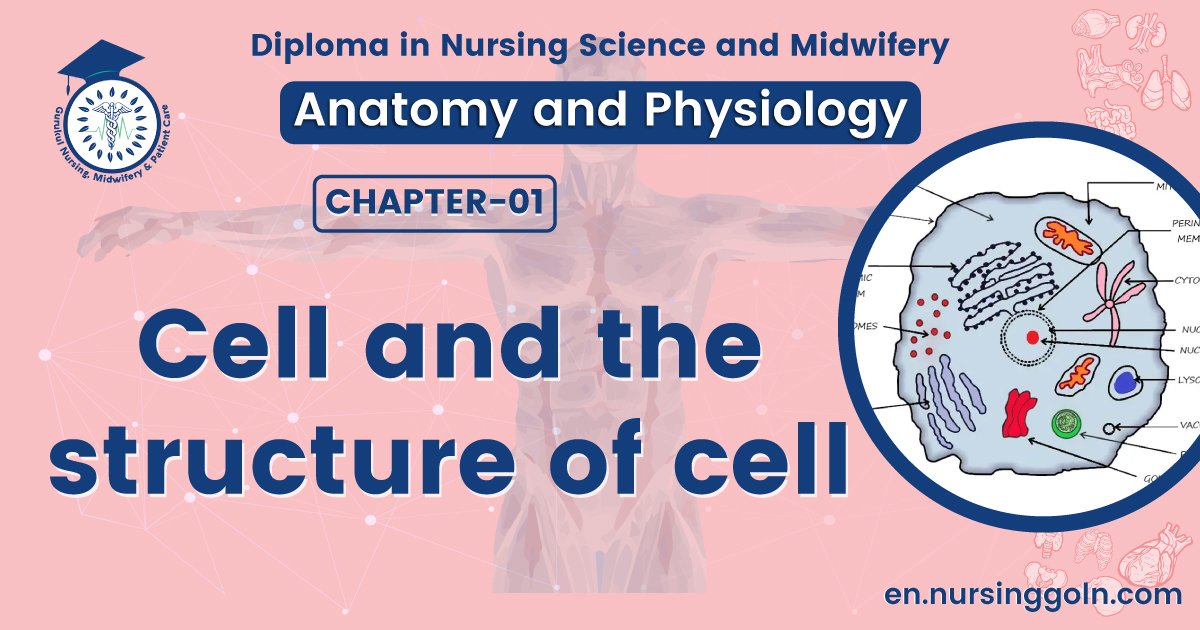Cell and the structure of cell-Some important Anatomical terminology-The course is designed for the basic understanding of anatomical structures and physiological functions of human body, musculoskeletal system, digestive system, respiratory system; cardiovascular system; urinary system, endocrine system, reproductive system, nervous system, hematologic system, sensory organs, integumentary system, and immune system. The aim of the course is to acquire knowledge and skills regarding anatomy and physiology.
Cell and the structure of cell

The structural and functional unit of all living organism is called cell. Cell is the structural & functional unit of the body.
The human body is made up of about 100 trillions of cells.
- Largest cell of human body: NEURON. [According to length].
- Largest cell of human body: MATURE OVUM. [According to size].
- Smallest cell of human body: PLATELET (Blood).

For ease of study, we can divide a cell into 3 main parts:. They are-
i. Protoplasm
ii. The plasma membrane
iii. Cytoplasm.
The nucleus is separated from the cytoplasm by nuclear membrane & cytoplasm is separated from the surrounding fluid by a cell membrane.
Protoplasm
The different substances that make up the cell are collectively called protoplasm. The protoplasm is composed of mainly 5 basic substances –
i. Water (70-85%).
ii.Electrolytes.
iii. Proteins.
i∨. Lipids.
∨. Carbohydrates.
PLASMA MEMBRANE:
The plasma membrane is the thin, outer membrane that separates the cell’s interior from its external environment. The plasma membrane also separates each cell from its neighboring cells, so that each cell is an individual entity. It requires an electron microscope to see it.
Functions
- Separates intracellular fluids from extracellular fluids
- Plays a dynamic role in cellular activity
- Transports of substances.
- Maintains size & shape of the cells.
- Secretes waste products. etc
Cytoplasm
The term cytoplasm refers to all of the cellular contents located between the plasma membrane and the nucleus. The semi-fluid portion of the cytoplasm is the cytosol, which is also called intracellular fluid. The organelles are suspended in the cytosol. So, the cytoplasm includes the cytosol and all the organelles (except the nucleus).
(Ref: Stuart Ira Fox, Human physiology. – 12th ed)

ORGANELLES:
Organelles are specialized structure or compartments within the cell that perform specific functions essential to cellular growth, maintenance, repair and control. Organelle means “little organs”, because each organelle performs its own job to maintain the life of the cell, like organs do in our bodies.
Cellular organelles:
Membranous
1. Mitochondria
2. Endoplasmic reticulum.
3. Golgi complex.
4. Lysosome.
5. Peroxisome
Non-membranous
1. Ribosome.
2. Centrosome.
3. Microfilament.
4. Microtubules
5. Intermediate filaments
Mitochondria: Mitochondria are the ‘powerhouse’ or the power-generating units of the cell, self replicating in nature and best developed in parts of the cells where energy-requiring processes take place.
Shape: “Sausage” shaped
Location:
Cytoplasm of cell but numerous in those cell where metabolic activity is more e.g.- Hepatocyte, cardiac cell, sperm etc,

Features:
1. The mitochondrial membrane is a lipid bilayer protein membrane, an outer and an inner membrane.
a) Inner mitochondrial membrane form cristae/shelves & contains enzymes, which is necessary for converting the products of carbohydrate, protein and fat metabolism to CO₂ & water. [ Four complex enzymes are involved i.e- NADH dehydrogenase, Succinic dehydrogenase, Cytocrome bc, and Cytochrome oxidase. ]
b) Outer mitochondrial membranecontains enzymes concerned with biologic oxidation providing raw materials for the reactions occurring inside the mitochondrion.
2. Mitochondria are “self replicative”
Functions:
- Production of ATP.
- Oxidation of nutrients.
- Helps in oxidative phosphorilation.
- Mitochondrial DNA synthesizes protein.
N.B: Sperm contributes no mitochondria to the zygote; therefore, mitochondria come from the ovum and inheritance is strictly maternal. Oxidative phosphorilation only occur in mitochondria.
(Ref:: Guyton and Hall, Textbook of Medical Physiology, 13th ed, P-16)

Mitochondria are membrane-bound organelles found in the cytoplasm of all eukaryotic cells that generate the cell’s primary energy molecule ATP (adenosine triphosphate).
Mitochondria are known as the powerhouse of the cell because it is responsible for the extracting energy from food through cellular respiration. The energy is released in the form of adenosine triphosphate (ATP). It is an energy currency of the cell.
THE NUCLEUS
The nucleus is one of the most important organelle in a cell that is not part of the cytoplasm. It is a spherical- or oval-shaped organelle surrounded by a double-layered membrane called the nuclear envelope (See the figure # 1.25).
Usually the largest organelle, the nucleus controls cellular activities and contains the genetic information. Most cells contain one nucleus. However, there are exceptions to the rule. Mature red blood cells have no nucleus; skeletal muscle cells contain several nuclei.
The nucleus contains (Chromatin) DNA, the hereditary genetic material of the cell. DNA controls the structure and activities of a cell by providing the instructions for protein synthesis.

Function of Nucleus
- Nucleus is the control centre of the cell.
- It is responsible for transmitting genetic information.
- It provides the instructions for protein synthesis.
(Ref:-J. TORTORA, 8th edition, P-58)
Read more:
